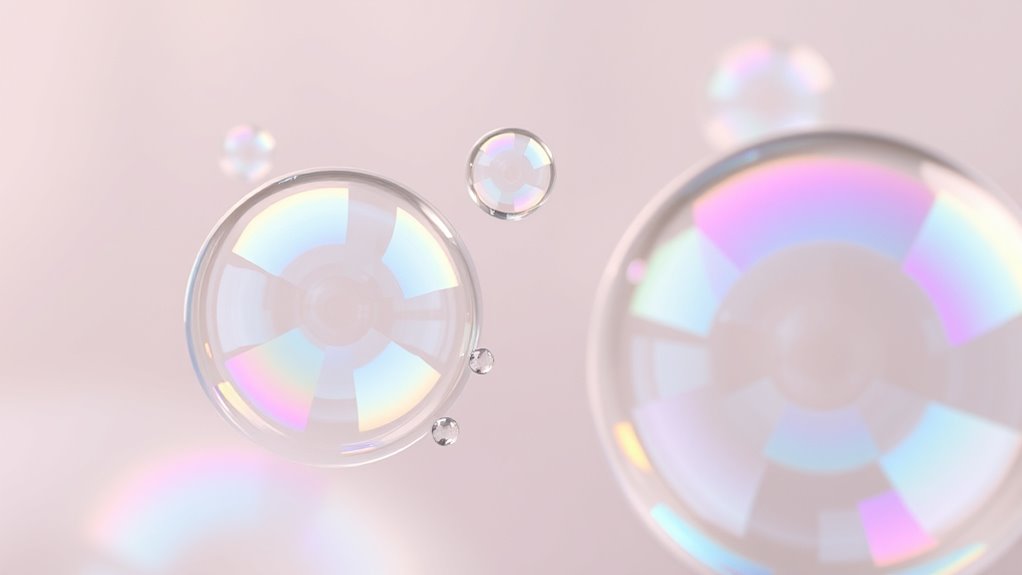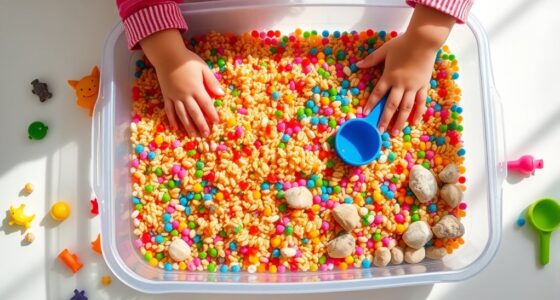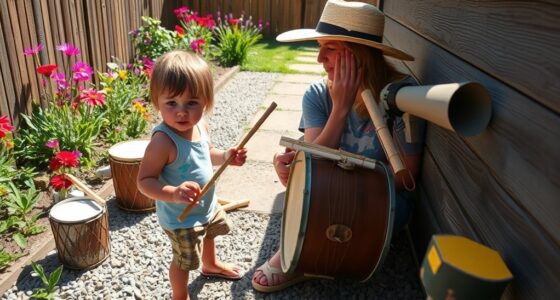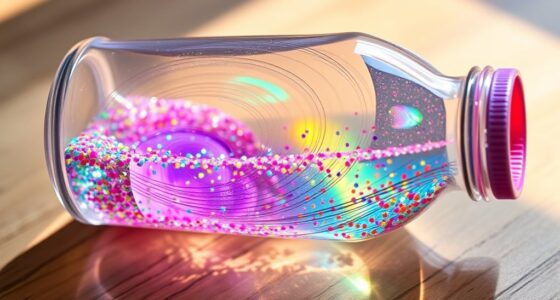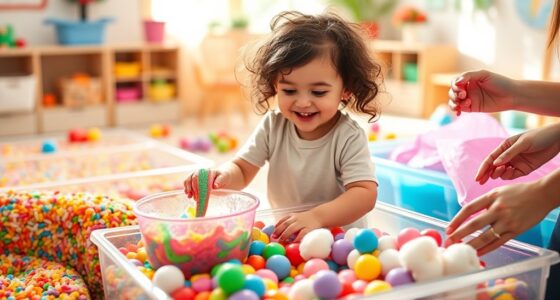When you make bubbles, soap spreads into a thin film around air, forming a round shape to minimize surface area. Soap reduces water’s surface tension, making it easier for bubbles to form and stay stable. This allows bubbles to grow larger and last longer. By understanding how soap weakens surface tension, you’ll see how bubbles stay colorful and fun. Keep exploring, and you’ll discover even more fascinating science behind bubbles and foam.
Key Takeaways
- Soap reduces water’s surface tension, making it easier to form and stretch bubbles.
- Bubbles are round because their shape minimizes surface area, which soap helps maintain.
- The soap film acts as a barrier, keeping bubbles stable and preventing them from popping quickly.
- Surface tension is the force that pulls the bubble’s film inward, balancing the air pressure inside.
- Soap makes bubbles longer-lasting and more colorful, turning a simple activity into a fun science experiment.
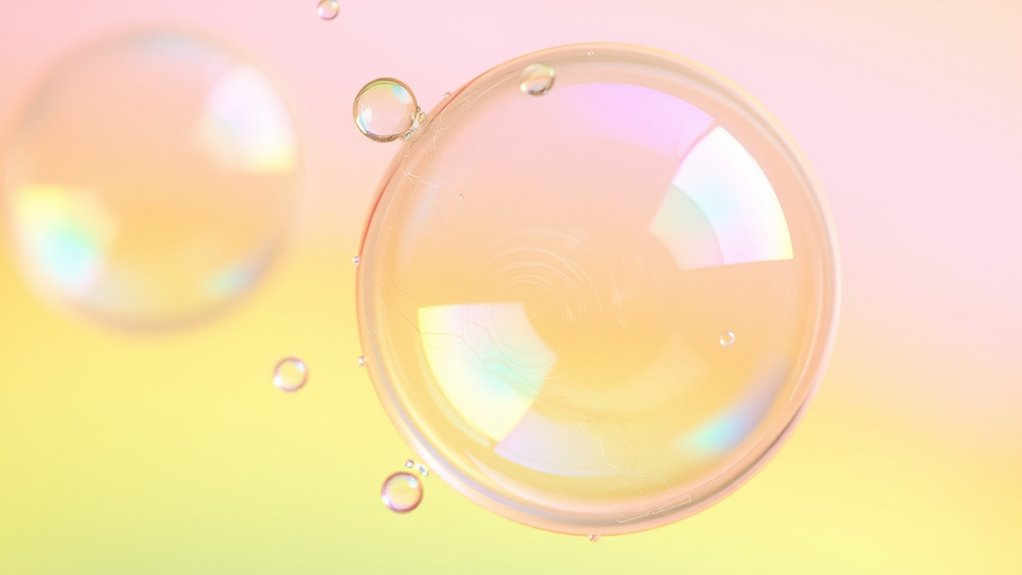
Bubble foam and soap science reveal the fascinating ways that tiny bubbles form, behave, and give us the satisfying experience of a frothy lather. When you look closely at foam, you see countless bubbles packed together, each with a thin film of liquid surrounding a pocket of air. The way these bubbles hold their shape depends heavily on the properties of the liquid inside the soap or bubble solution. These liquid properties, especially surface tension, are key to understanding how bubbles stay intact and how foam forms.
Surface tension is what makes the surface of a liquid behave like a stretched elastic sheet. Imagine holding a small droplet of soap solution on your finger. The liquid pulls inward, trying to minimize its surface area. When you mix soap into water, it changes the liquid’s surface tension, making the water molecules less tightly bound at the surface. This reduction allows bubbles to form more easily and makes their films more flexible. Without soap, pure water has high surface tension, so it resists stretching and the bubbles are short-lived or won’t form well at all.
Soap lowers water’s surface tension, making bubbles easier to form and more flexible.
When you blow soap bubbles, the soap solution spreads into a thin film that encloses air, creating a bubble. The surface tension pulls the liquid molecules inward, giving the bubble its round shape. The round shape is the most efficient way to minimize the surface area, which is why bubbles are sphere-shaped. Because of the soap’s ability to lower surface tension, the bubble film stays stretched and stable longer than pure water would allow. This is why bubbles can grow bigger and last longer when soap is added.
Inside the bubble, the liquid film is extremely thin. The molecules at the surface are pulled inward due to surface tension, which balances the pressure of the air inside. When the bubble moves or pops, it’s because the surface tension can no longer hold the film together, often due to disruptions like dust or friction. Soap also creates a stable film by forming a barrier that prevents the liquid from quickly evaporating or breaking apart.
Understanding these liquid properties and surface tension helps you see why soap is so effective at making bubbles and foam. The science behind it shows you that bubbles aren’t just fun—they’re a window into how liquids behave and interact with air. With soap, you get beautiful, long-lasting bubbles because of how it changes surface tension and allows the liquid film to stretch and hold its shape. So the next time you blow bubbles, remember that these tiny spheres are a wonderful display of science in action, all thanks to the special properties of the soap solution.
Frequently Asked Questions
How Do Bubbles Stay Together Without Popping Immediately?
Bubbles stay together without popping immediately because of surface tension, which creates a strong, elastic skin around the bubble. This surface tension helps maintain bubble stability by evenly distributing the soap film’s forces. When the soap solution forms a thin film, surface tension keeps it from bursting instantly. That’s why bubbles can float and shimmer, lasting a little longer before eventually popping due to environmental factors or loss of moisture.
Why Do Some Soaps Create More Bubbles Than Others?
It’s funny how some soaps seem to produce endless bubbles, right? The secret lies in their ingredients. Soaps with more surfactants and thicker formulas create smaller, more numerous bubbles, while gentler soaps produce fewer, larger ones. The bubble size depends on these ingredients, and if you want a bubble explosion, choose a soap with the right mix. So yes, soap ingredients truly make all the difference!
What Makes Bubble Foam Different From Regular Foam?
Bubble foam differs from regular foam mainly in bubble composition and foam formation. Bubbles are tiny, thin-walled spheres filled with air or gas, giving bubble foam its light, airy feel. Regular foam, on the other hand, has a denser, less uniform structure. The key is how the bubbles in bubble foam are formed and stabilized, creating a surface that’s smooth and shiny, unlike the more solid look of regular foam.
Can Soap Bubbles Be Used for Cleaning?
Yes, soap bubbles can be used for cleaning! Their large, delicate bubble size captures dirt and grease like tiny magnets. The soap ingredients create a thin, flexible film that lifts grime from surfaces. When you pop a bubble, it releases its trapped dirt, helping you tidy up. So next time you see bubbles, remember—they’re not just fun but also a clever cleaning tool!
How Does Soap Affect the Surface Tension of Water?
Soap reduces the surface tension of water by disrupting molecular interactions at the water’s surface. When you add soap, it embeds itself between water molecules, weakening the cohesive forces that hold them together. This change allows the water to spread more easily and form bubbles. So, by lowering surface tension, soap makes water more effective at cleaning and helps create those stretchy, durable bubbles you love to blow.
Conclusion
Now that you’ve explored bubble foam and soap science, you see how fun learning can be. By experimenting with bubbles, you uncover the magic behind everyday things. Remember, “A little knowledge is a dangerous thing,” so keep exploring and asking questions. With each discovery, you’re building a strong foundation for future science adventures. Keep your curiosity alive, and you’ll find that learning is never too small or too simple to enjoy.

